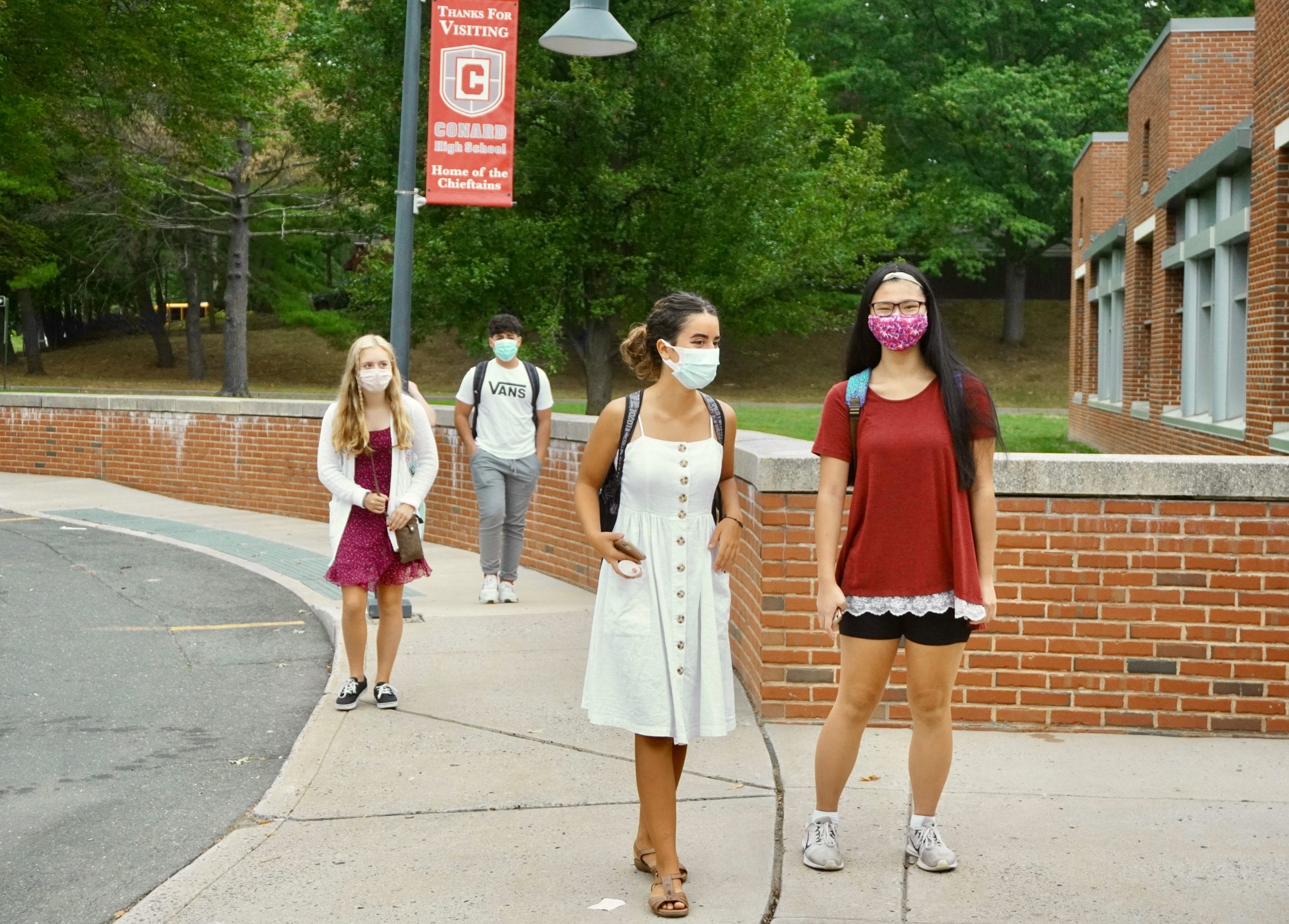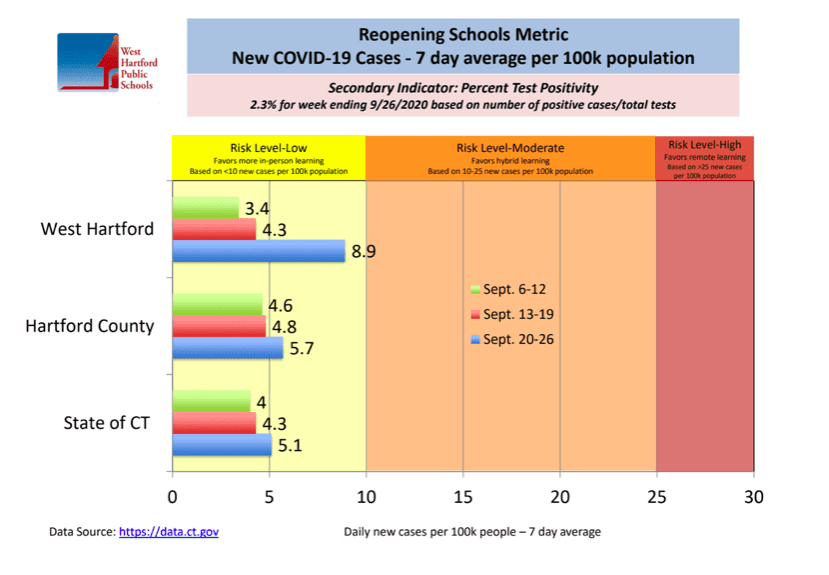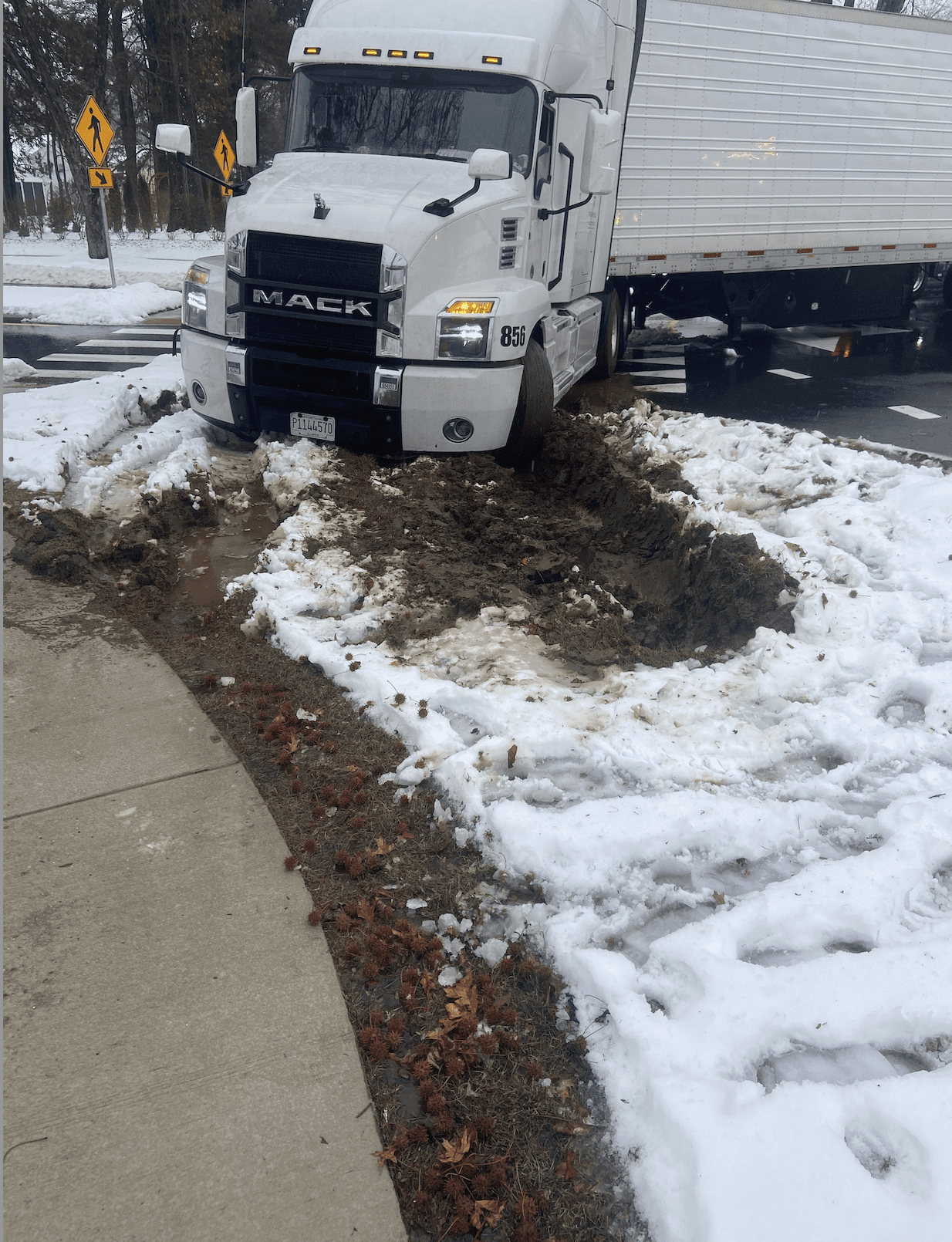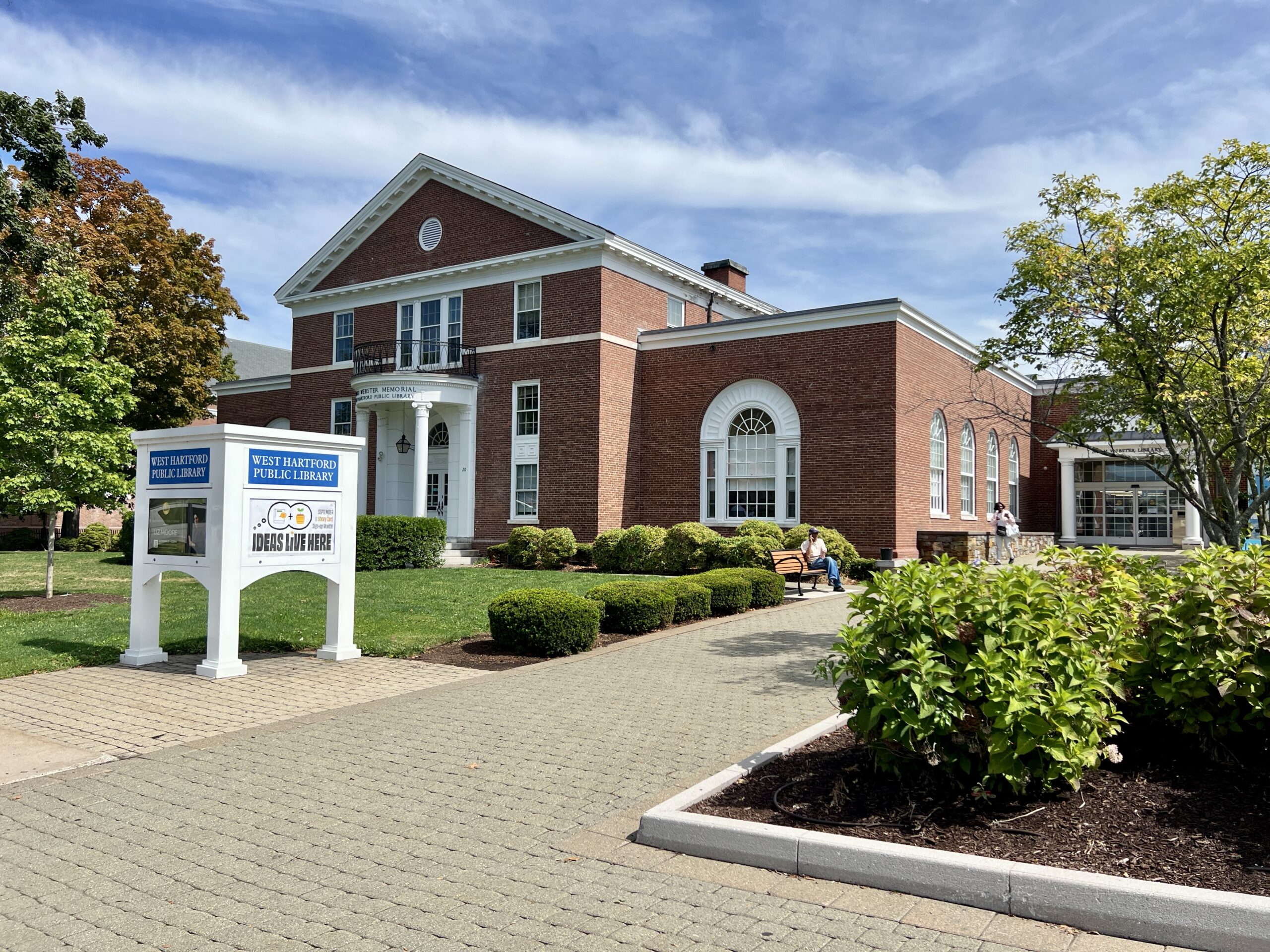West Hartford Public Schools Consider Tweaks to Hybrid Model

Audio By Carbonatix

Students arrive at Conard High School. First day of school in West Hartford, Part 2. Sept. 10, 2020. Photo credit: Ronni Newton (we-ha.com file photo)
West Hartford Public Schools administrators provided an update to the Board of Education Tuesday night regarding the metrics behind the decision to remain in hybrid mode, and provided an outline of possible changes to the hybrid model.
By Ronni Newton
The plan was for West Hartford Public Schools to transition from hybrid to full in-person learning beginning with the elementary schools on Oct. 13, but after reviewing COVID-19 data released last Friday, Superintendent Tom Moore made what he said was a very difficult decision to put those plans on hold.
Some parents – particularly parents of elementary age students where childcare needs are critical and students struggle with hybrid learning – were up in arms after learning about the pause, but Moore said it was a choice that had to be made, and that no one wants to have all of the students back in school full time more than he does.
“It is our goal. It is our desire,” he said. But he noted that if the Board directed him to move forward with a full reopening right now, they would be directing him not to follow public health guidelines.
“We are still planning to come back, full in person, at some point once the number stabilize,” Moore said.
Moore and Assistant Superintendent of Administration Andy Morrow provided the Board with further insight into why the plans changed overnight, and Assistant Superintendent for Curriculum, Instruction and Assessment Paul Vicinus summarized plans to increase instructional time by adding more structure, including introduction of streaming, to the hybrid model.
The decision
“This is a very different conversation than we anticipated having today,” Morrow told the Board. As of last Thursday, everything looked great for elementary students to transition to full, in-person on Oct. 13, and he anticipated those would be the plans he would be presenting to the Board.
“Things changed rather quickly and we had to go ahead and pivot and make the determination. We had to pause,” said Morrow. “The data is what it is … and the numbers that we are seeing were completely unexpected.”
The report received by administrators Friday morning, which included data for the week ending Sept. 26, noted 39 new COVID-19 cases in West Hartford, up from 19 the previous week. The town’s seven-day average of new cases per 100,000 rose to 8.9 (from 4.3 the previous week, and 3.4 the week before that), and the positivity rate had jumped from 1.3% to 2.3% from the previous week.
As of Tuesday night, within West Hartford Public Schools there had only been six confirmed cases of COVID-19 since schools reopened on Sept. 8. The dashboard is updated daily at noon, and Wednesday indicated no active cases in any of the public schools – although Moore confirmed later Wednesday that one case had been reported at Bristow Middle School later in the day.
While there are cases in the West Hartford and the Greater Hartford community, West Hartford Public Schools have not been a source of transmission.
“None of them are from school,” Morrow said. “There is no transmission in the classroom.”
Additional cases are anticipated in the schools, however, because they are a reflection of cases in the community.

Screenshot from WHPS COVID-19 dashboard
In deciding whether to be open in-person, hybrid, or fully remote, administrators use indicators outlined in Addendum Four of the state’s school reopening plan.
The district was comfortable with the number of cases per 100,000 in the 2.5 to 3.5 range, where it had been for the previous month, and 4.3 was still acceptable, Morrow said. The plan was for opening in hybrid to get everyone used to the new protocols, and then to have a phased return to full in-person.
“The metrics in Addendum Four are not about spread in the schools – they are about spread in the community,” Moore told We-Ha.com. He said the Department of Public Health’s guidelines aren’t looking at the number of cases in schools but in the community, and the secondary indicators which are also critical are statistically significant and trending in the wrong direction.
Moore said Wednesday that keeping students 6 feet apart, with masks, has kept the case count low in the schools. “So the solution by many is that everyone should thus be back in school,” he said, but due to the amount of available classroom space that would mean that students would be just 3 to 4 feet apart – at a time when the number of cases in our town, and Hartford County, are greatly increasing.
“During a time of diminished community spread there is less need for that mitigation step,” Moore said. “We can focus more on masking as the primary tool.” That’s not where the community is at this point in time.
Based on case count as of Tuesday, Moore said there had been 48 positive cases in the past week, which would mean the number of cases per 100,000 would be close to 11.
“Hopefully it levels out,” Moore said. He said he doesn’t want to have to keep changing the plan.
The City of Hartford, where more than half of the students have chosen remote learning, announced this week that they will likely move to hybrid mode effective Oct. 19.

Screenshot, Connecticut Open Data
Moore also noted that it’s tough to compare West Hartford to some of its neighboring towns like Farmington, Avon, and Simsbury. Not only is West Hartford larger, but it’s more cosmopolitan, and there is denser housing, more congregate settings, and many residents go to work in places like Hartford, Bloomfield, East Hartford, and New Britain, where cases per 100,000 exceed 10.
In the same data set released Friday morning, Avon had seven cases, a rate of 5.5 per 100,000, and 1.7% positivity; Farmington had seven cases, a rate of 3.9 per 100,000, and 1.0 positivity; and Simsbury had less than five cases, a rate of 1.7 per 100,000, and 0.5% positivity. But with a smaller population, an outbreak in just one family can skew the numbers.
The administration is in daily contact with the health district, with experts, and with other area districts, and the decisions are science-based and are not arbitrary. “We are not sitting behind closed doors making this up,” Morrow said.
This is not a time to be reckless, he added. “I am not going to apologize if at times we defer on the side of caution.”
Where are West Hartford’s cases
Aimee Krauss, director of the West Hartford-Bloomfield Health District, provided some additional insight Wednesday into West Hartford’s COVID-19 cases in response to some questions from We-Ha.com.
She also provided the latest data for the Health District (see PDF below), which will soon be posted on the town’s website.
While West Hartford Public Schools has not indicated many cases, they exist in the community.
“We have seen an increase in cases … According to the lead DPH epidemiologist we are at the beginning of our re-surge,” Krauss said.
The data provided by the Health District has consistently shown about 50 more cases than what is reported daily by the state (992 reported on Oct. 6, compared to 947 reported by DPH), but the daily increase is roughly the same. Krauss said the Health District includes probable as well as confirmed cases.
“We’ve seen increase in family clusters and a few isolated cases in our skilled facilities,” she said.
“The [Health] District is continuing with contact tracing for every positive case we have received and then contacting those individual contacts to the positive case. We are checking in with our positive cases daily, making sure that people have enough food and supplies. If one of our residents needs assistance we work with our social service department for those needs,” Krauss said.
Through that contact tracing, the Health District has determined that cases seem to come from individuals attending social gatherings and not maintaining 6-feet of distance or not wearing a mask.
“We have seen cases from workplaces and cases who are asymptomatic,” Krauss said. “We do have families that test positive and each case is considered a positive case.”
Krauss said that four large families are currently being monitored. “When individuals await test results they should remain home and quarantine until those results are received,” she urged.
Some additional advice provided by Krauss: “As we come into flu season I would remind people to remain at home if they are sick and to contact their healthcare provider. As our cases increase we are reminding people to get their flu shot. They may call the Health District to schedule an appointment.”
On Wednesday, Gov. Ned Lamont reported 123 new positive cases in the state, a rate of 1.6%. The rolling average of positive cases for the past seven days is 1.2% per CovidActNow.org.
Today’s COVID-19 update in Connecticut:
➡️7,617 tests were administered and 123 came back positive (1.6% positivity rate)
➡️138 patients are hospitalized (increase of 9)
➡️There has been 1 COVID-related deathFor more data, visit https://t.co/FpgO8W27I0 pic.twitter.com/BKB06SxTUf
— Governor Ned Lamont (@GovNedLamont) October 7, 2020
Hybrid changes
“The news of our postponing our reopening was at the very least extremely disappointing,” Vicinus, the assistant superintendent tasked with overseeing the curriculum, said at Tuesday night’s Board meeting. He said when he saw Moore and Morrow walk into his office together Friday morning, he knew it wasn’t going to be good news.
There were seven members of the public – parents and a grandparent – who spoke at the beginning of the meeting, many of them expressing dissatisfaction with the current hybrid model. Vicinus said he knows that people are disappointed with the amount of instructional time students are receiving.
He cautioned, however, against making direct comparisons to other districts where the hybrid model is completely based on streaming from the classroom to students who are at home.
West Hartford’s model, which combines shorter in-school days with remote learning blocks in the afternoons for the students who are “off,” is the only one that guarantees instructional time to students who are at home. Streaming to elementary school students, particularly the younger students is “simply not effective” and many of the districts that have started off that way are changing their delivery.
Vicinus also expressed his disappointment that the district is not able to move to full in-person.
“Given that our current metrics are keeping us in the hybrid mode for a period of time longer … we will be implementing changes to the hybrid plan to improve it,” Vicinus told We-Ha.com on Wednesday. The changes will be particularly to increase instructional time.
Strategies include more flexible use of the afternoon time for the elementary students, and implementing live streaming for the secondary school students – together with an instruction model that supports it.
The leadership team will be meeting and fine-tuning plans over the next few weeks, Vicinus said. Some additional professional development with teachers will likely be required, and will perhaps involve some shuffling of the cohort schedules for a few days in order to accommodate that time before any changes are implemented.
It will not mean that every teacher will just stand in front of both the students in class and those watching remotely for an entire class period.
The district doesn’t have enough webcams to livestream every class right now, and Vicinus said phasing it in will be a good way to test the waters. Some classes might not make sense to stream either.
A level of engagement is expected, Vicinus said, and the expectation is that students who are home are doing schoolwork during the day in advance of their synchronous afternoon sessions with teachers.
“The problem is that there is no ability to supervise their receipt of those activities,” and while it’s important for students to have some flexibility, it “runs the gamut,” Vicinus said.
Adding an element of streaming while keeping the direct instruction piece in place for both the students who are in school and those who are at home is key. “That’s what sets our hybrid apart,” Vicinus said. The students at home will be required to attend the sessions that are streamed, and that will provide additional structure, while both groups of students will have direct instruction with teachers.
“Some districts are doing all day on screen. That’s just too lengthy,” Vicinus said. There will be a guideline provided to teachers.
There will be at least a few weeks notice to families before changes are made, to ensure that the message is properly communicated and students are prepared for more structure in their home-week schedule. The upcoming end of the marking period, and the nature of the rotation of the cohort schedule will also be factors in the implementation schedule, Vicinus said.
There is also going to be ongoing discussion about implementation of changes to the hybrid plan for elementary school students, particularly the younger students where streaming is not as effective and creates a greater burden on caregivers.
While the administration can’t predict at this point when students will be able to return to full in-person school, Vicinus said included in the discussion will be the possibility of staggering a return of elementary school students, bringing back lower grades first.
Parents speak out
There were eight members of the public who addressed the Board of Education Tuesday night – seven at the beginning of the meeting and one at the end. Most of the comments focused on the lack of instructional time under the hybrid model.
“I feel educationally it’s falling short,” Christine Kruczek, who has a senior at Hall High School, said of the current hybrid model. She said students who are on an off week only get two hours of education per day, and advocated for the live-streaming model.
“Believe me I’m not blaming the teachers. I think they’re working hard,” said Edward Siegel, the grandfather of two students. He said students need more support, and help figuring out how to do their homework.
Rebecca Warchut, the parent of a Braeburn kindergartner and second grader, said it “is much safer and educationally much more sound” to have students in school full time rather than in hybrid, which undermines cohorting. “We need a staggered plan to bring back our youngest students to school as soon as possible,” she said.
“I second that the hybrid model is not working and is falling on the backs of many parents and caregivers to uphold their children’s learning,” said Sarah Miner. She urged the Board to be the voice for parents and caregivers as well as students.
Teresa Switzer said she appreciates the hard work the teachers have been doing and agrees it is a very difficult time, but she wanted the Board to understand that high school kids who are home are only getting 25% of their education on a good day – when the WiFi in the schools is working properly. “Twenty-five percent is not good for our kids. … We need to give our kids more than that”
Karli Heneghan, whose children are in kindergarten and sixth grade, expressed concern that the students are not coming back full time and said for the youngest students who are learning to read, it’s critical that they reach targets by the end of third grade. “[This] needs to be taken seriously and have urgency behind it.”
Heather Maynard, a teacher in another district who has four children, several of whom are still in West Hartford schools, commended Moore on pausing the return to full in-person classes. She expressed concern that those who are remote don’t have access to all of the same classes, and also noted the difficulty of transferring between the hybrid and the remote learning experience.
Diana Sziabowski, who spoke at the end of the meeting, said she feels the hybrid model is denying students education. Her children are in first and third grade, and she said careers are at stake because for the elementary students the responsibilities are on the backs of the families.
Message from Mayor Shari Cantor
COVID-19 cases are coming from the workplace, family gatherings, and social activities where people are not wearing masks and physically distancing, Mayor Shari Cantor said.
“We know this is impacting spread,” she said. “It’s more important than ever to wear masks.”
Cantor also urged people to be cautious, to stay home if they are sick – even if it’s just a scratchy throat, or a headache, or they think it’s allergies.
“Stay home. Get tested,” said Cantor. “Act as if you have [COVID-19].”
This is the start of a new surge, said Cantor. “More than ever, we have to stay vigilant.”
Like what you see here? Click here to subscribe to We-Ha’s newsletter so you’ll always be in the know about what’s happening in West Hartford! Click the blue button below to become a supporter of We-Ha.com and our efforts to continue producing quality journalism.
 Loading...
Loading...




What is astounding to me as a parent is that Mr. Morrow could state “…and the numbers that we are seeing were completely unexpected.”
Any normal, functioning adult KNEW that as we transitioned from late summer to fall to winter that these numbers would go up. Based on what we saw in March / April, not to mention hundreds of published articles which detail why / how COVID-19 spreads and/or cluster breakouts in places as far as Arizona and as close as Danbury, we know this virus has the ability to spread quickly. This alone makes me wonder what Mr. Morrow is thinking when he makes such foolish / outlandish statements….[Maybe he drinks the same Kool-Aid as our President?]
So where that leads us is the fact that the statement below is a COMPLETE LIE when it comes to previous decisions made by Superintendent Moore and his staff:
In deciding whether to be open in-person, hybrid, or fully remote, administrators use indicators outlined in Addendum Four of the state’s school reopening plan.
When Superintendent Moore sent his email on email on Friday July 31 – making an ABRUPT switch from all of his previous correspondence throughout the summer indicating that the Town would be starting full in person – he showed his cards in that what is said in Addendum Four DOES NOT MATTER. At that time, both primary and secondary indicators STRONGLY supported full in person learning – but it did not matter. So again, that statement is a FLAT OUT LIE.
And here we are. ~5 weeks into hybrid and heading NOT towards a return to in person, but more likely to full remote learning as the days get colder, people head indoors and we enter common cold and influenza season.
So to Superintendent Moore and Asst Superintendent Morrow, moving forward lets call a spade a spade. Do not provide false hope that you are hopeful we may still move to full in person. I think we all know now that will not be happening anytime soon. You have already shown your cards, and we all now how you will be playing your hand….
If you read my coverage of the decision to open in hybrid mode it notes that in addition to the leading indicators in Addendum 4, there are the secondary indicators and other factors. The size of the schools and the inability to provide 6 feet of separation between students were major factors in the decision to open in hybrid mode.
With all due respect, the physical space of our schools has not changed. 6 feet spacing with hybrid vs 3-4 feet spacing with full in person were always going to be those “numbers” – nothing was going to change that (aside from a significant amount of our families abruptly saying they would rather go full online). If this spacing distance was a key and/or critical factor, then AGAIN, Superintendent Moore should have said from the get go – i.e. full in person will not be possible due to spacing issues. That was never said…. not once.
We all know the Addendum Four numbers (primary and secondary indicators) were as good as they were ever going to be at the beginning of the school year. Only a FOOL would have thought the numbers were going to get better as it gets colder and people are forced inside. So to keep saying that we are trying to get back to full in person is nothing more than lie at this point….
[Not to mention a few pieces of correspondences that came from the schools prior to this decision which showed the schools in A/B hybrid mode past October 13th – all of which were deemed “honest mistakes”…..]
Thank you for your reporting…it is much appreciated
[…] for the secondary schools, but in a letter to the community Friday afternoon said that either tweaks to the hybrid model which were outlined earlier in the week, or a return to in-person, might happen around Election […]